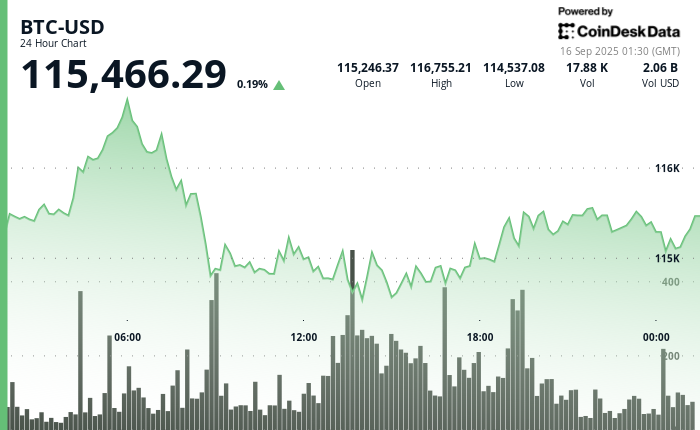Uncategorized
Why Trump’s Tariffs Could Actually Be Good for Bitcoin

So far, crypto markets haven’t behaved as expected under the Trump Administration. Investors hoped that regulatory reform and policies like a Bitcoin Strategic Reserve would drive prices appreciably higher. But it’s been the opposite. Bitcoin has fallen from highs well above $100,000 at the beginning of the year to a trough in the mid-80,000s for most of March.
Crypto prices have suffered from being increasingly correlated with traditional assets like stocks and bonds, which have been hit by macroeconomic uncertainty. Tariffs — surcharges the U.S. places on imports from other countries — have Wall Street worried about a global recession. Crypto investors have been steering clear of crypto assets, which are seen as relatively risky.
“This is all about markets’ ‘risk appetite’ which continues to deteriorate, and for the time being drives a wedge between crypto assets and gold, which continues to be the ‘safe haven’ of choice,” said Marc Ostwald, Chief Economist & Global Strategist at ADM Investor Services International.
“[That’s] in no small part driven by central bank FX reserve managers, who are seeking to reduce USD exposure, which has long been a source of concern to them.”
As the global financial and trade system becomes more fragmented, investors are seeking alternatives to riskier assets, including dollars. For now, that means turning to gold, which is up 18% year-to-date.
But that could change, said Omid Malekan, an adjunct professor at Columbia Business School and author of «The Story of the Blockchain: A Beginner’s Guide to the Technology That Nobody Understands.» Bitcoin could be the new gold soon enough.
“I think the entire [future] is uncertain and in some ways unknowable, because there are many crosscurrents and both crypto and tariffs are new. Some people argue that crypto is just a risk-on tech asset and would sell off due to tariffs. But bitcoin has found footing in some circles as ‘digital gold’ and the physical variety is soaring on the tariff news. So which will it be?”
In other words, economic uncertainty could lead investors to seek out bitcoin just as they have sought out gold in recent months.
Another note of positivity: the impact of tariffs on crypto could be “priced in” and the worst might be over already, said Zach Pandl, head of research at Grayscale, a leading crypto asset management firm.
President Trump is due to announce U.S. tariffs on Wednesday, April 2, at 4 p.m. ET—what’s known as “Liberation Day.” According to reports, he’ll lay out “reciprocal tariffs” against 15 countries that have levied tariffs against the U.S., including China, Canada and Mexico.
Pandl estimates tariffs have so far taken 2% off economic growth this year. But Liberation Day might actually stop the worst of the pain felt in financial markets. “If we see an announcement [on Wednesday] that is tough but phased, and focused on the 15 countries they seem to be targeting, my expectation is that markets will rally on that news,” Pandl told CoinDesk.
“Potentially once we get through this announcement, crypto markets can focus back on the fundamentals which are very positive.”Pandl said announcements like Circle’s IPO wouldn’t be happening if institutions didn’t have a high degree of confidence in the digital assets sector and the policies around it.
Moreover, Pandl, a former macro-economist at Goldman Sachs, believes that tariffs will increase the appetite for currencies that aren’t dollars.
“I think tariffs will weaken the dominant role of the dollar and create space for competitors including bitcoin. Prices have gone down in the short run. But the first few months of the Trump Administration have raised my conviction in the longer term for bitcoin as a global monetary asset.”
Pendl still believes that bitcoin will hit new all-time highs this year, despite current pessimism around prices. “I wouldn’t have quit my Wall Street job if I didn’t think bitcoin will be the winner in the long term,” he said.
Uncategorized
Asia Morning Briefing: Fragility or Back on Track? BTC Holds the Line at $115K

Good Morning, Asia. Here’s what’s making news in the markets:
Welcome to Asia Morning Briefing, a daily summary of top stories during U.S. hours and an overview of market moves and analysis. For a detailed overview of U.S. markets, see CoinDesk’s Crypto Daybook Americas.
Bitcoin (BTC) traded just above $115k in Asia Tuesday morning, slipping slightly after a strong start to the week.
The modest pullback followed a run of inflows into U.S. spot ETFs and lingering optimism that the Federal Reserve will cut rates next week. The moves left traders divided: is this recovery built on fragile foundations, or is crypto firmly back on track after last week’s CPI-driven jitters?
That debate is playing out across research desks. Glassnode’s weekly pulse emphasizes fragility. While ETF inflows surged nearly 200% last week and futures open interest jumped, the underlying spot market looks weak.
Buying conviction remains shallow, Glassnode writes, funding rates have softened, and profit-taking is on the rise with more than 92% of supply in profit.
Options traders have also scaled back downside hedges, pushing volatility spreads lower, which Glassnode warns leaves the market exposed if risk returns. The core message: ETFs and futures are supporting the rally, but without stronger spot flows, BTC remains vulnerable.
QCP takes the other side.
The Singapore-based desk says crypto is “back on track” after CPI confirmed tariff-led inflation without major surprises. They highlight five consecutive days of sizeable BTC ETF inflows, ETH’s biggest inflow in two weeks, and strength in XRP and SOL even after ETF delays.
Traders, they argue, are interpreting regulatory postponements as inevitability rather than rejection. With the Altcoin Season Index at a 90-day high, QCP sees BTC consolidation above $115k as the launchpad for rotation into higher-beta assets.
The divide underscores how Bitcoin’s current range near $115k–$116k is a battleground. Glassnode calls it fragile optimism; QCP calls it momentum. Which side is right may depend on whether ETF inflows keep offsetting profit-taking in the weeks ahead.

Market Movement
BTC: Bitcoin is consolidating near the $115,000 level as traders square positions ahead of expected U.S. Fed policy moves; institutional demand via spot Bitcoin ETFs is supporting upside
ETH: ETH is trading near $4500 in a key resistance band; gains are being helped by renewed institutional demand, tightening supply (exchange outflows), and positive technical setups.
Gold: Gold continues to hold near record highs, underpinned by expectations of Fed interest rate cuts, inflation risk, and investor demand for safe havens; gains tempered somewhat by profit‑taking and a firmer U.S. dollar
Nikkei 225: Japan’s Nikkei 225 topped 45,000 for the first time Monday, leading Asia-Pacific gains as upbeat U.S.-China trade talks and a TikTok divestment framework lifted sentiment.
S&P 500: The S&P 500 rose 0.5% to close above 6,600 for the first time on Monday as upbeat U.S.-China trade talks and anticipation of a Fed meeting lifted stocks.
Elsewhere in Crypto
Uncategorized
Wall Street Bank Citigroup Sees Ether Falling to $4,300 by Year-End

Wall Street giant Citigroup (C) has launched new ether (ETH) forecasts, calling for $4,300 by year-end, which would be a decline from the current $4,515.
That’s the base case though. The bank’s full assessment is wide enough to drive an army regiment through, with the bull case being $6,400 and the bear case $2,200.
The bank analysts said network activity remains the key driver of ether’s value, but much of the recent growth has been on layer-2s, where value “pass-through” to Ethereum’s base layer is unclear.
Citi assumes just 30% of layer-2 activity contributes to ether’s valuation, putting current prices above its activity-based model, likely due to strong inflows and excitement around tokenization and stablecoins.
A layer 1 network is the base layer, or the underlying infrastructure of a blockchain. Layer 2 refers to a set of off-chain systems or separate blockchains built on top of layer 1s.
Exchange-traded fund (ETF) flows, though smaller than bitcoin’s (BTC), have a bigger price impact per dollar, but Citi expects them to remain limited given ether’s smaller market cap and lower visibility with new investors.
Macro factors are seen adding only modest support. With equities already near the bank’s S&P 500 6,600 target, the analysts do not expect major upside from risk assets.
Read more: Ether Bigger Beneficiary of Digital Asset Treasuries Than Bitcoin or Solana: StanChart
Uncategorized
XLM Sees Heavy Volatility as Institutional Selling Weighs on Price

Stellar’s XLM token endured sharp swings over the past 24 hours, tumbling 3% as institutional selling pressure dominated order books. The asset declined from $0.39 to $0.38 between September 14 at 15:00 and September 15 at 14:00, with trading volumes peaking at 101.32 million—nearly triple its 24-hour average. The heaviest liquidation struck during the morning hours of September 15, when XLM collapsed from $0.395 to $0.376 within two hours, establishing $0.395 as firm resistance while tentative support formed near $0.375.
Despite the broader downtrend, intraday action highlighted moments of resilience. From 13:15 to 14:14 on September 15, XLM staged a brief recovery, jumping from $0.378 to a session high of $0.383 before closing the hour at $0.380. Trading volume surged above 10 million units during this window, with 3.45 million changing hands in a single minute as bulls attempted to push past resistance. While sellers capped momentum, the consolidation zone around $0.380–$0.381 now represents a potential support base.
Market dynamics suggest distribution patterns consistent with institutional profit-taking. The persistent supply overhead has reinforced resistance at $0.395, where repeated rally attempts have failed, while the emergence of support near $0.375 reflects opportunistic buying during liquidation waves. For traders, the $0.375–$0.395 band has become the key battleground that will define near-term direction.

Technical Indicators
- XLM retreated 3% from $0.39 to $0.38 during the previous 24-hours from 14 September 15:00 to 15 September 14:00.
- Trading volume peaked at 101.32 million during the 08:00 hour, nearly triple the 24-hour average of 24.47 million.
- Strong resistance established around $0.395 level during morning selloff.
- Key support emerged near $0.375 where buying interest materialized.
- Price range of $0.019 representing 5% volatility between peak and trough.
- Recovery attempts reached $0.383 by 13:00 before encountering selling pressure.
- Consolidation pattern formed around $0.380-$0.381 zone suggesting new support level.
Disclaimer: Parts of this article were generated with the assistance from AI tools and reviewed by our editorial team to ensure accuracy and adherence to our standards. For more information, see CoinDesk’s full AI Policy.
-

 Business11 месяцев ago
Business11 месяцев ago3 Ways to make your business presentation more relatable
-

 Fashion11 месяцев ago
Fashion11 месяцев agoAccording to Dior Couture, this taboo fashion accessory is back
-

 Entertainment11 месяцев ago
Entertainment11 месяцев ago10 Artists who retired from music and made a comeback
-

 Entertainment11 месяцев ago
Entertainment11 месяцев ago\’Better Call Saul\’ has been renewed for a fourth season
-

 Entertainment11 месяцев ago
Entertainment11 месяцев agoNew Season 8 Walking Dead trailer flashes forward in time
-

 Business11 месяцев ago
Business11 месяцев ago15 Habits that could be hurting your business relationships
-

 Entertainment11 месяцев ago
Entertainment11 месяцев agoMeet Superman\’s grandfather in new trailer for Krypton
-

 Entertainment11 месяцев ago
Entertainment11 месяцев agoDisney\’s live-action Aladdin finally finds its stars





